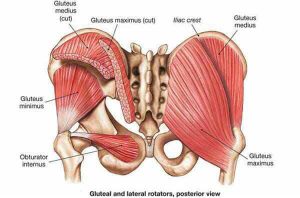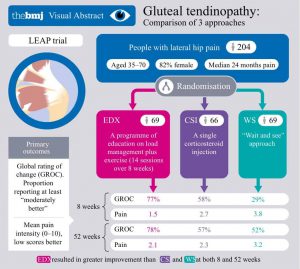
Are you experiencing pain on the outside of your hip? You could have gluteal tendinopathy. Often called Greater Trochanteric Bursitis (or hip bursitis), there have been some exciting developments in the management of this condition. Maddy Parker, one of our Caringbah physios, explains for you.
Gluteal tendinopathy is a common and quite disabling condition, affecting both athletes (particularly running sports) and less active people alike. Research has shown it effects 1 in 4 women over 50 and has similar effects on our quality of life as severe hip arthritis.

The gluteal tendons (gluteus minimus, medius and maximus see above) are the tough fibres that connect your glutei or butt muscles into your hip bone. A tendon injury is usually the result of repetitive overloading (overloading=more activity than the tendon can cope with, maybe because of an increase in activity levels) and results in many tiny tears to the tendon that have accumulated over time.
Tendinopathy occurs in one of two ways. Tendonitis which means “inflammation of the tendon,” but in-fact, this is a relatively rare cause of tendon pain. The most common form of tendinopathy is Tendinosis, a non-inflammatory degenerative condition that is characterised by collagen degeneration (or breaking down) in the tendon due to repetitive overloading. Tendinopathies do not respond well to anti-inflammatory treatments and are best treated with a comprehensive functional rehabilitation program.
A recent and really well conducted study, the LEAP Trial (Mellor et al., 2018) released in July 2018 is looking to be a game changer in the way we manage gluteal tendinopathies. This study showed the best management of gluteal tendinopathy comes from an approach combining progressive exercise therapy and education.
Participants in the study were aged 35 to 70, had hip pain for more than three months with a pain score of at least 4/10 and a clinical diagnosis of gluteal tendionopathy.
The study compared 3 groups (seen below in the infographic);
The first group were given a progressive exercise program to improve the load capacity of the gluteal muscles along with education mainly around avoiding painful compressive movements (for example, running with a cross-midline foot strike, bringing your leg across your body in sitting/walking and particular sleeping positions).
“Wait and see” group had 1 session with a physiotherapist who provided general information about gluteal tendinopathy, risk factors, continuing activity and prognosis.

The education and exercise group performed better than the corticosteroid injection and the wait and see groups for gluteal tendinopathy.
At the 8 week follow up time, education and exercise achieved an impressive 77% global change success rate. This was better than both the corticosteriod injection group (58%) and wait and see group (29%). Hip pain intensity was also significantly better in the education and exercise group at 8 weeks.
At the follow up mark, 1 whole year later, the global rating of change within the education and exercise group remained significantly high. It was better than the other groups with a 78% success rate compared to 57% for the injection group and 52% for the wait and see approach. Also, at one year follow up, the success rates seen in the corticosteriod injection group were not significantly different from the wait and see approach.
As you can see for the infographic picture above, it is interesting to note that after 1 year, over 50% of patients with gluteal tendinopathy in this study had improvements in global rating without treatment, although both education and exercise and the corticosteriod injection group reported less pain at this time point. Also of note, the global rating of change was superior in education and exercise versus injection, although their pain levels reported were of similar value.
This is the first high quality trial within the physio world to show that education and exercise can be effective in managing gluteal tendinopathy, a condition we see so often.
The mixture of exercises used in this study included a functional retraining, targeted rehab for the hip and thigh muscles (especially the glute muscles) and worked towards developing dynamic control of the gluteal and inner thigh muscles during function (it doesn’t matter if you don’t know the specifics of those exercises, your physiotherapist will!).
The study supports the idea that managing tendinopathy is more about identifying an individual’s current levels and rehab needs and progressing them towards their goals (whether that be competing in marathons or walking their dog around the block) through developing an individualised rehab program, rather than using one specific approach being applied to all.
Here at The Healthy Body Company, we pride ourselves on delivering the best and most-taliored care to all our patients so we can get you back doing what you love, as quickly and as best as possible. If you think you might be suffering with a gluteal tendinopathy, get in touch and let us help you ????
If you’re a bit nerdy like us and would like to have a read of the study mentioned above, have a read here: https://www.bmj.com/content/361/bmj.k1662